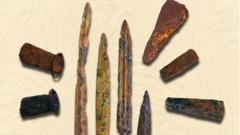Over the past two decades, archaeological explorations in Tamil Nadu, a southern state in India, have painted a riveting picture of the region’s ancient history, including hints of advanced urban civilizations and global trade routes. Recently, a significant discovery has emerged: evidence indicating that the making and use of iron may have originated in Tamil Nadu, potentially marking an earlier start of the Iron Age than previously accepted narratives.
Archaeologists have unearthed iron artifacts across six sites in Tamil Nadu, with dates ranging from approximately 2,953 to 3,345 BCE, which translates to a remarkable 5,000 to 5,400 years ago. With this discovery, the narrative surrounding the advent of iron technology faces recalibration. Prior to this, Turkey was regarded as one of the initial centers for significant iron mining and smelting, around the 13th century BCE.
Dilip Kumar Chakrabarti, a South Asian archaeology professor at Cambridge University, emphasizes the importance of these findings, indicating that their full implications will take time to grasp. The headlines emerging from Tamil Nadu proclaim, "Did the Iron Age Begin in Tamil Nadu?" posing crucial inquiries about the evolution of iron usage and production in ancient societies.
However, experts urge caution against jumping to conclusions of a singular origin for the Iron Age. Parth R Chauhan, from the Indian Institute of Science Education and Research (ISSER), suggests that iron technology likely emerged independently across various regions. He notes that many areas have not undergone thorough research, and the dating of some evidence remains uncertain. Fellow archaeologist Oishi Roy points out that these finds hint at parallel developments in iron production globally.
Historic discoveries also include sites mentioned, such as Kodumanal, which unveiled ancient iron smelting furnaces indicating a community actively engaged in iron production. Artefacts like hoe-spades, knives, arrowheads, and swords, have emerged from burial sites, showcasing the advanced metallurgical skills of these ancient inhabitants.
In particular, one finding of an iron sword made of ultra-high-carbon steel, dating back to between the 13th and 15th century BCE, suggests that the techniques used in Tamil Nadu may predate similar methods identified in Turkey. As historian Osmund Bopearachchi points out, the evidence raises compelling questions about the evolution of steel production in both regions.
Despite these groundbreaking revelations, experts acknowledge that excavations need to be more widespread across India to yield a complete understanding of the Iron Age's origins. Indicating that current knowledge is limited to Tamil Nadu’s discoveries is a start, but the collective journey into India’s iron heritage can lead to even richer insights.
Katragadda Paddayya, a prominent Indian archaeologist, insists that these findings mark only the beginning of exploration into the roots of iron technology. As excavations continue, there's hope for further elucidation, which could reveal how and where iron production began much earlier, enriching our understanding of ancient civilizations and their technological advancements.
Archaeologists have unearthed iron artifacts across six sites in Tamil Nadu, with dates ranging from approximately 2,953 to 3,345 BCE, which translates to a remarkable 5,000 to 5,400 years ago. With this discovery, the narrative surrounding the advent of iron technology faces recalibration. Prior to this, Turkey was regarded as one of the initial centers for significant iron mining and smelting, around the 13th century BCE.
Dilip Kumar Chakrabarti, a South Asian archaeology professor at Cambridge University, emphasizes the importance of these findings, indicating that their full implications will take time to grasp. The headlines emerging from Tamil Nadu proclaim, "Did the Iron Age Begin in Tamil Nadu?" posing crucial inquiries about the evolution of iron usage and production in ancient societies.
However, experts urge caution against jumping to conclusions of a singular origin for the Iron Age. Parth R Chauhan, from the Indian Institute of Science Education and Research (ISSER), suggests that iron technology likely emerged independently across various regions. He notes that many areas have not undergone thorough research, and the dating of some evidence remains uncertain. Fellow archaeologist Oishi Roy points out that these finds hint at parallel developments in iron production globally.
Historic discoveries also include sites mentioned, such as Kodumanal, which unveiled ancient iron smelting furnaces indicating a community actively engaged in iron production. Artefacts like hoe-spades, knives, arrowheads, and swords, have emerged from burial sites, showcasing the advanced metallurgical skills of these ancient inhabitants.
In particular, one finding of an iron sword made of ultra-high-carbon steel, dating back to between the 13th and 15th century BCE, suggests that the techniques used in Tamil Nadu may predate similar methods identified in Turkey. As historian Osmund Bopearachchi points out, the evidence raises compelling questions about the evolution of steel production in both regions.
Despite these groundbreaking revelations, experts acknowledge that excavations need to be more widespread across India to yield a complete understanding of the Iron Age's origins. Indicating that current knowledge is limited to Tamil Nadu’s discoveries is a start, but the collective journey into India’s iron heritage can lead to even richer insights.
Katragadda Paddayya, a prominent Indian archaeologist, insists that these findings mark only the beginning of exploration into the roots of iron technology. As excavations continue, there's hope for further elucidation, which could reveal how and where iron production began much earlier, enriching our understanding of ancient civilizations and their technological advancements.




















